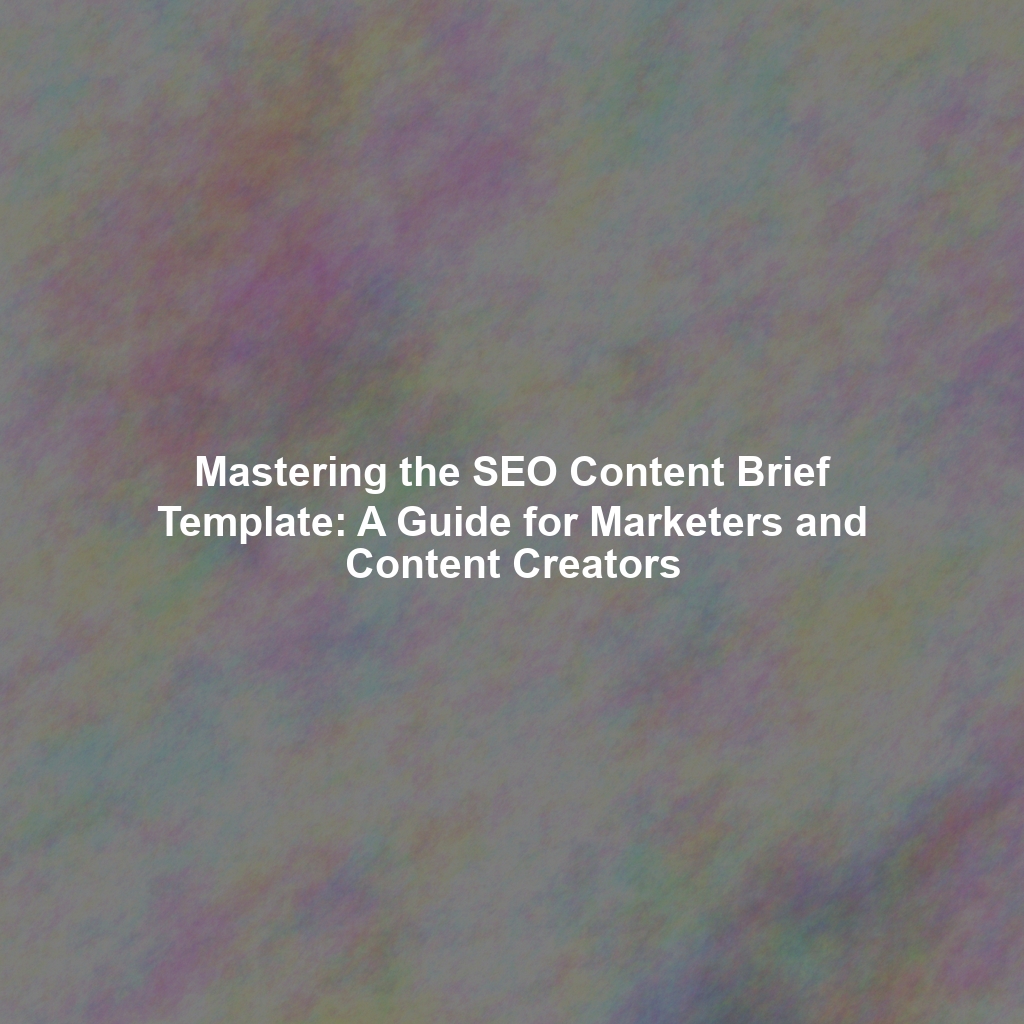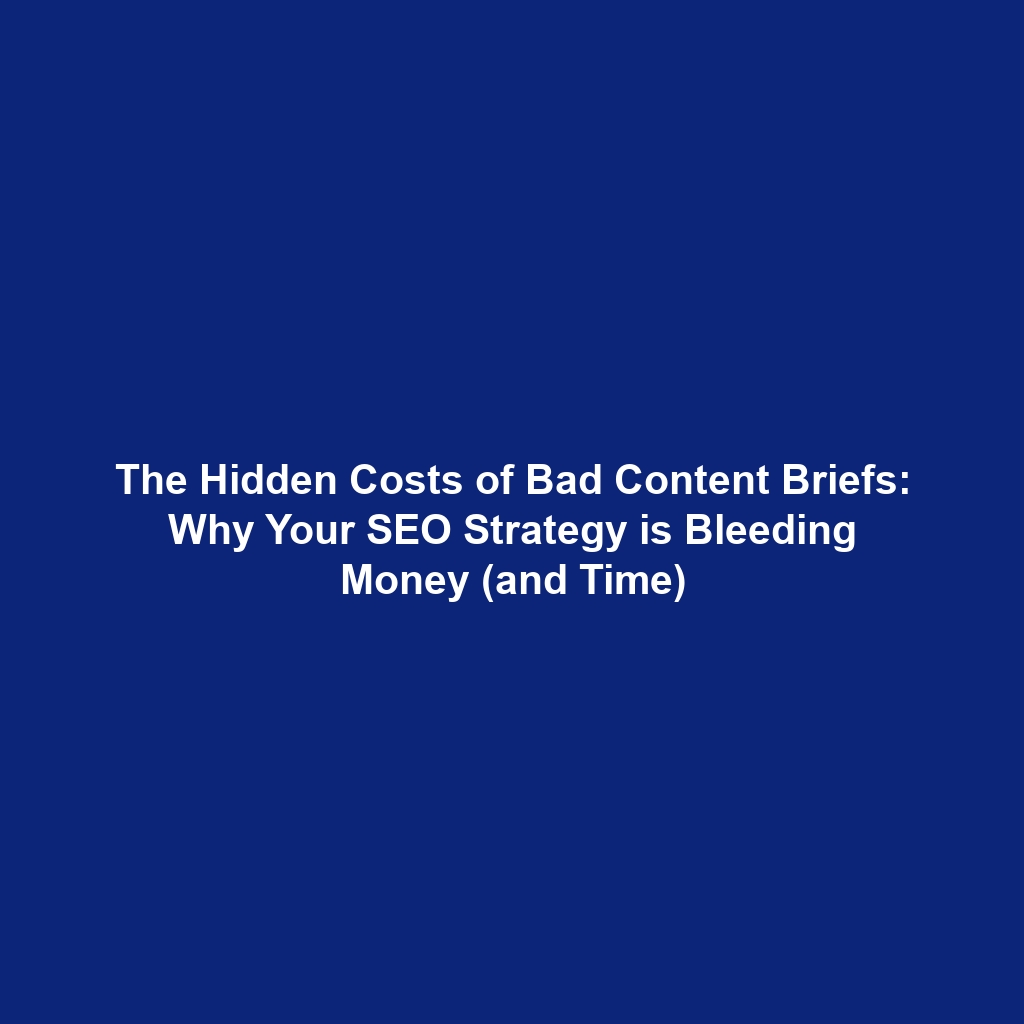Understanding the Importance of an SEO Content Brief Template
Creating compelling content is no longer enough. To truly succeed, your content must be strategically optimized for search engines.
An SEO content brief template serves as the cornerstone of this strategy, providing a detailed roadmap for content creators to produce high-quality, search-engine-friendly material. Without a well-defined content brief, you risk creating content that misses the mark in terms of both user intent and SEO performance. This can lead to wasted time, resources, and ultimately, a failure to achieve your marketing goals.
A comprehensive SEO content brief template acts as a central document that aligns content creation with your overall SEO strategy. It ensures that all team members, from writers to designers, are on the same page and working towards a common objective. This includes understanding the target audience, the primary and secondary keywords, the desired tone of voice, and the overall purpose of the content. A well-executed content brief increases the likelihood of ranking higher in search engine results pages (SERPs), attracting more organic traffic, and ultimately, driving conversions.
PS – I specifically built a tool (Brief Buddy) to do all of the below, at a fraction of the cost of what the major players charge, and with fewer buttons and inputs, so less work for you. Just put in a topic and who your target audience is and click go. Please check it out!
Key Elements of an Effective SEO Content Brief Template
Creating an effective SEO content brief template requires a deep understanding of SEO principles and content marketing best practices. Here’s a breakdown of the essential elements that should be included in your template.
1. Project Overview and Goals
Start by outlining the project’s overarching goals. What are you trying to achieve with this content? Are you aiming to increase brand awareness, generate leads, drive sales, or educate your audience? Clearly defining the goals will help guide the content creation process and ensure that the final product aligns with your overall marketing objectives. For example, if your goal is to increase brand awareness for a new product, the content brief should specify that the content should focus on highlighting the product’s unique features and benefits, and targeting a broad audience.
Furthermore, include a summary of the target audience. Who are you trying to reach with this content? What are their pain points, interests, and needs? Understanding your audience is crucial for crafting content that resonates with them and provides value. Consider creating detailed buyer personas to represent your ideal customer and use these personas to inform your content strategy. Resources like the Wikipedia article on Buyer Personas can provide a deeper understanding of persona development.
2. Keyword Research and Targeting
Keyword research is the foundation of any successful SEO strategy. The content brief should clearly specify the primary and secondary keywords that the content should target. The primary keyword is the main search term that you want to rank for, while secondary keywords are related terms that can help to broaden your reach and improve your overall SEO performance. Use tools like Google Keyword Planner, Ahrefs, or SEMrush to identify relevant keywords with high search volume and low competition.
In addition to identifying the keywords, the content brief should also provide guidance on how to use them effectively. This includes specifying the keyword density (the percentage of times the keyword appears in the content), as well as where to place the keywords within the content (e.g., in the title, headings, and body text). Consider using long-tail keywords, which are longer, more specific search terms that can help you to attract a more targeted audience. For example, instead of targeting the broad keyword “coffee,” you might target the long-tail keyword “best organic coffee beans for cold brew.”
3. Content Outline and Structure
A well-structured content outline is essential for creating a clear and engaging piece of content. The content brief should include a detailed outline that specifies the main topics and subtopics that the content should cover. This outline should be logical and easy to follow, and it should ensure that the content flows smoothly from one point to the next. Consider using headings and subheadings to break up the text and make it easier to read.
The outline should also include specific instructions for each section of the content. This might include specifying the tone of voice, the target audience, and the desired length. For example, you might specify that the introduction should be written in a friendly and engaging tone, and that it should be targeted towards beginners. The body of the content should then delve into the topic in more detail, providing expert insights and practical examples.
4. Tone and Style Guidelines
Maintaining a consistent tone and style across all of your content is crucial for building a strong brand identity. The content brief should clearly specify the desired tone of voice for the content. Is it formal or informal? Professional or casual? Authoritative or friendly? The tone of voice should be consistent with your brand’s overall personality and values.
In addition to the tone of voice, the content brief should also specify the desired writing style. This might include specifying the use of active or passive voice, the length of sentences and paragraphs, and the use of jargon or technical terms. Provide examples of content that exemplify the desired tone and style to give the writer a clear understanding of your expectations. Consider referencing established style guides, such as the Associated Press (AP) Stylebook, which can provide guidance on grammar, punctuation, and usage.
5. Call to Action (CTA)
Every piece of content should have a clear call to action (CTA) that encourages the reader to take the next step. The content brief should specify the desired CTA, as well as where it should be placed within the content. The CTA should be relevant to the content and aligned with your overall marketing goals. For example, if the goal of the content is to generate leads, the CTA might encourage the reader to download a free ebook or sign up for a webinar. The CTA should be clear, concise, and compelling, and it should stand out from the rest of the content. Consider using strong action verbs and creating a sense of urgency to encourage the reader to take action. Examples include “Download Now,” “Get Started Today,” or “Learn More.”
6. SEO Metadata and Optimization
The content brief should include specific instructions for optimizing the content for search engines. This includes specifying the meta title, meta description, and alt text for images. The meta title and meta description are the snippets of text that appear in search engine results pages (SERPs), and they play a crucial role in attracting clicks. The meta title should be concise and keyword-rich, while the meta description should provide a brief summary of the content and encourage the reader to click through. Alt text is used to describe images to search engines and visually impaired users. It should be descriptive and include relevant keywords.
In addition to optimizing the metadata, the content brief should also provide guidance on internal and external linking. Internal links are links to other pages on your website, while external links are links to other websites. Internal links can help to improve your website’s SEO by distributing link juice and improving the overall site structure. External links can help to establish your credibility and provide additional resources for your readers. Ensure that all links are relevant and high-quality. Consider linking to reputable sources, such as academic journals, industry publications, and government websites. For example, you might link to the SEMrush blog for more information on SEO content templates.
7. Content Format and Visual Elements
The content brief should specify the desired content format and visual elements. This might include specifying the use of images, videos, infographics, or other multimedia elements. Visual elements can help to break up the text and make the content more engaging. They can also help to illustrate complex concepts and provide additional context. Ensure that all visual elements are high-quality and relevant to the content. Consider using original images or creating custom graphics to stand out from the competition.
The content brief should also specify the desired content format. Is it a blog post, an article, a white paper, or a case study? The format should be appropriate for the target audience and the overall marketing goals. For example, if you are targeting a technical audience, a white paper might be a more appropriate format than a blog post. If you are trying to generate leads, a case study might be a more effective format than an article.
Creating Your Own SEO Content Brief Template: A Step-by-Step Guide
Now that you understand the key elements of an effective SEO content brief template, let’s walk through the process of creating your own template. Here’s a step-by-step guide:
- **Choose a Template Format:** You can create your template in a variety of formats, such as a Word document, a Google Doc, or a spreadsheet. Choose the format that works best for your team and your workflow.
- **Include the Essential Elements:** Make sure to include all of the essential elements outlined above, such as the project overview, keyword research, content outline, tone and style guidelines, call to action, SEO metadata, and content format.
- **Customize the Template:** Customize the template to fit your specific needs and requirements. Add or remove sections as needed, and tailor the language to your brand’s voice.
- **Provide Examples and Instructions:** Provide clear examples and instructions for each section of the template. This will help to ensure that everyone on your team understands how to use the template effectively.
- **Regularly Review and Update:** Regularly review and update the template to ensure that it remains relevant and effective. As SEO best practices evolve, you may need to make changes to your template to stay ahead of the curve.
Benefits of Using an SEO Content Brief Template
Using an SEO content brief template offers numerous benefits, including:
- **Improved SEO Performance:** By providing clear guidance on keyword targeting, content structure, and SEO metadata, a content brief can help to improve your website’s SEO performance and drive more organic traffic.
- **Increased Content Quality:** A content brief ensures that all content is high-quality, relevant, and engaging, which can lead to increased user engagement and conversions.
- **Enhanced Team Collaboration:** A content brief promotes collaboration among team members by providing a shared understanding of the project goals and requirements.
- **Streamlined Content Creation Process:** A content brief streamlines the content creation process by providing a clear roadmap for writers and designers.
- **Reduced Errors and Revisions:** By providing clear instructions and expectations, a content brief can help to reduce errors and revisions, saving time and resources.
Advanced Tips for Optimizing Your SEO Content Brief Template
To take your SEO content brief template to the next level, consider these advanced tips:
- **Integrate with SEO Tools:** Integrate your content brief template with SEO tools like Ahrefs or SEMrush to streamline the keyword research process and provide real-time data.
- **Use a Content Management System (CMS):** Consider using a CMS like WordPress to manage your content and track its performance.
- **Track Content Performance:** Track the performance of your content using analytics tools like Google Analytics to measure its success and identify areas for improvement.
- **A/B Test Different Content Briefs:** A/B test different content briefs to see which ones perform best. This can help you to optimize your template and improve your overall content strategy.
- **Incorporate User Intent Analysis:** Conduct a thorough user intent analysis to understand what users are searching for when they type in specific keywords. This will help you to create content that truly meets their needs.
Conclusion: The SEO Content Brief Template as a Foundation for Success
In conclusion, an SEO content brief template is an indispensable tool for marketers and content creators who want to create high-quality, search-engine-friendly content. By following the steps outlined in this guide, you can create a template that will help you to improve your website’s SEO performance, increase content quality, and streamline the content creation process. Remember to regularly review and update your template to ensure that it remains relevant and effective in the ever-changing world of digital marketing. By mastering the art of the SEO content brief, you can lay a solid foundation for long-term success in the online arena. Companies like HubSpot are strong proponents of content briefs within their content strategy.


